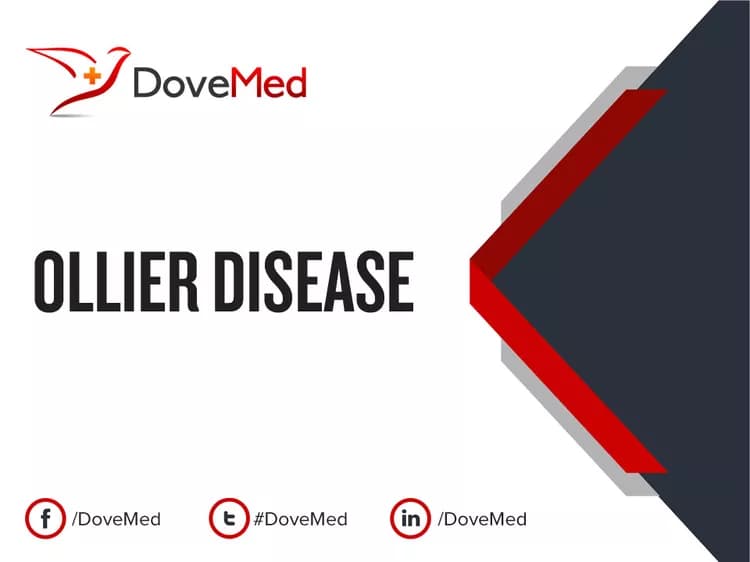What are the other Names for this Condition? (Also known as/Synonyms)
- Enchondromatosis
- Multiple Cartilaginous Enchondroses
- Ollier’s Disease
What is Ollier Disease? (Definition/Background Information)
- Ollier Disease is a rare, genetic disorder that is characterised by abnormal bone development and formation of tumors in the cartilage
- This condition specifically affects the long bones (arms and legs) and the cartilage that connects the various long bones. The abnormal growth of the long bones causes the outer layer of the bones to become thin and brittle
- Bone deformities, asymmetric bone growth, tumor of the ovary, benign tumors of the bone, called enchondromas, and skin lesions are some known symptoms of Ollier Disease. This condition may be diagnosed through conventional imaging modalities and clinical examinations
- The treatment options include rectifying the bone deformities through successive surgeries. Nevertheless, no other treatment options are available for those with Ollier Disease
- Ollier Disease could lead to serious complications such as frequent bone fractures, bone disintegration, and malignant transformations. As a result, the disorder and its progression is typically unpredictable
Who gets Ollier Disease? (Age and Sex Distribution)
- Ollier Disease is a congenital disorder manifested at birth; however, the symptoms do not appear until the child reaches 10 years of age
- Boys are reported to have an increased risk of developing the condition than girls
- This disorder is rare, having a prevalence rate of 1:100,000
- Ollier Disease is seen worldwide and all races and ethnicities are at risk
What are the Risk Factors for Ollier Disease? (Predisposing Factors)
- Currently, the risk factors for Ollier Disease are not well-established
- The male gender may be a risk factor, since boys are affected more than girls
It is important to note that having a risk factor does not mean that one will get the condition. A risk factor increases ones chances of getting a condition compared to an individual without the risk factors. Some risk factors are more important than others.
Also, not having a risk factor does not mean that an individual will not get the condition. It is always important to discuss the effect of risk factors with your healthcare provider.
What are the Causes of Ollier Disease? (Etiology)
- Ollier Disease is a genetic disorder with spontaneous origin. However, it is neither inherited nor does it run in the families
- The cause for Ollier’s Disease is a combination of mutations occurring on genes, which have not been identified yet
What are the Signs and Symptoms of Ollier Disease?
The long bones of the arms and legs are typically affected by Ollier Disease. There is involvement of the cartilage connecting these bones as well. Additionally, the pelvis, the ribs, breast bones and skull may also be affected.
The common signs and symptoms of Ollier Disease include:
- Abnormal bone development and limb growth
- Deformities of the bone, reduced growth of bones
- Enchondromas (benign bone tumor originating from cartilage tissues)
- Short stature
- Asymmetric growth of bones
- Granulosa - cell tumors of the ovary
How is Ollier Disease Diagnosed?
Ollier Disease can be diagnosed through clinical and radiological studies
- In children, x-rays to reveal bone lesions when they have not crossed the growth plate
- Scintigraphy,ultrasound, and MRI scans are used to evaluate bone growth and tumor
- In case of suspected malignancy, a tissue biopsy may be recommended
- Skin biopsy, in case of any subcutaneous nodules
Many clinical conditions may have similar signs and symptoms. Your healthcare provider may perform additional tests to rule out other clinical conditions to arrive at a definitive diagnosis.
What are the possible Complications of Ollier Disease?
Ollier Disease could possibly lead to the following complications:
- Bone lysis, which is disintegration of the bone
- Frequent bone fractures
- Exostosis: The development of new bone on the surface of the existing bone
- Subcutaneous nodules (Elevated lesions just below the skin)
- Disproportionate stature
- Hemangioma: A non cancerous blood vessel tumor
How is Ollier Disease Treated?
Currently, there is no cure for Ollier Disease and symptomatic treatment and supportive therapy is provided.
- Surgery is recommended in case of complications such as:
- Pathological fractures
- Growth defect
- Malignant transformations
- Multiple surgeries may have to be planned, if there are unequal limbs due to asymmetric growths and joint distortions
- Physiotherapy can help with mobility and arm/leg movement
How can Ollier Disease be Prevented?
Currently, it is not possible to prevent the occurrence of Ollier Disease.
What is the Prognosis of Ollier Disease? (Outcomes/Resolutions)
- The prognosis of Ollier Disease is usually variable and guarded. It may be severe in those having an early onset of the condition
- There is also a 5-50% chance of a malignant transformation, which can indicate a poor prognosis
Additional and Relevant Useful Information for Ollier Disease:
The various classifications of enchondromatosis (condition where benign tumors of the cartilage form) include:
- Ollier’s Disease
- Maffucci’s syndrome
- Generalised enchondromatosis
Related Articles
Test Your Knowledge
Asked by users
Related Centers
Related Specialties
Related Physicians
Related Procedures
Related Resources
Join DoveHubs
and connect with fellow professionals


0 Comments
Please log in to post a comment.